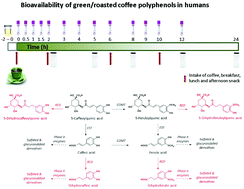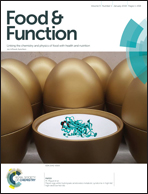Bioavailability of hydroxycinnamates in an instant green/roasted coffee blend in humans. Identification of novel colonic metabolites†
Abstract
Roasting greatly reduces the phenolic content in green coffee beans. Considering the beneficial effects of coffee polyphenols, blends containing green coffee beans are being consumed as a healthier alternative to roasted coffee. This study was aimed at assessing the absorption and metabolism of hydroxycinnamates in an instant green/roasted (35/65) coffee blend in healthy humans. Twelve fasting men and women consumed a cup of coffee containing 269.5 mg (760.6 μmol) of chlorogenic acids. Blood and urine samples were taken before and after coffee consumption at different times and analyzed by LC-MS-QToF. Up to 25 and 42 metabolites were identified in plasma and urine, respectively, mainly in the form of sulfate and methyl derivatives, and to a lower extent as glucuronides. Un-metabolized hydroxycinnamate esters (caffeoyl-, feruloyl-, and coumaroylquinic acids), hydroxycinnamic acids (caffeic, ferulic and coumaric acids) and their phase II metabolites, in addition to phase II derivatives of lactones, represented a minor group of metabolites (16.3% of the metabolites excreted in urine) with kinetics compatible with small intestine absorption. Dihydrohydroxycinnamic acids and their phase II derivatives, in addition to feruloylglycine, showed delayed kinetics due to their colonic origin and represented the most abundant group of metabolites (75.7% of total urinary metabolites). Dihydrohydroxycinnamate esters (dihydroferuloyl-, dihydrocaffeoyl- and dihydrocoumaroylquinic acids) have been identified for the first time in both plasma and urine, with microbial origin (excreted 8–12 h after coffee intake) amounting to 8% of total urinary metabolites. In conclusion, coffee polyphenols are partially bioavailable and extensively metabolized, mainly by the colonic microbiota.

- This article is part of the themed collection: Around the Supermarket: Staple Foods


 Please wait while we load your content...
Please wait while we load your content...